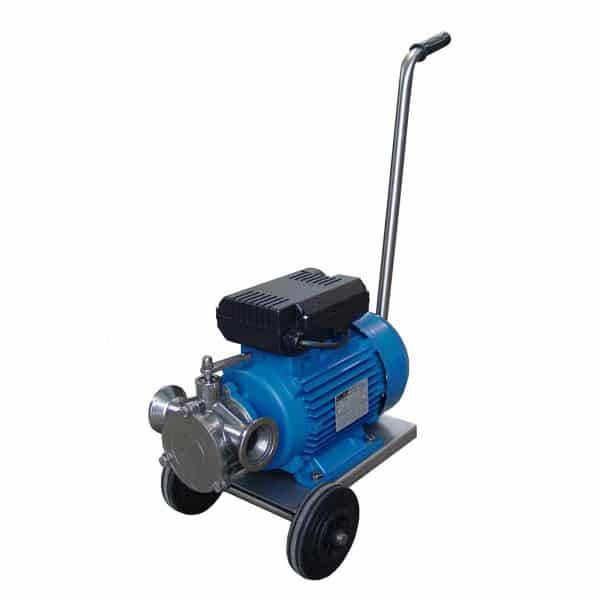Nanobreweries – small home and craft breweries
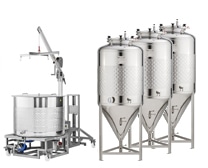 Nano-breweries are the small home breweries and the small craft breweries based on beer production technology focusing on the lowest purchase price at the cost of reduced operating comfort in the brewery (compared to industrial mini-breweries and mini-breweries). Nano-breweries are a suitable solution for all beginners who require the full functionality of the facility with the smallest possible investment in technology and construction work.
Nano-breweries are the small home breweries and the small craft breweries based on beer production technology focusing on the lowest purchase price at the cost of reduced operating comfort in the brewery (compared to industrial mini-breweries and mini-breweries). Nano-breweries are a suitable solution for all beginners who require the full functionality of the facility with the smallest possible investment in technology and construction work.
We offer BREWMASTER sets for nano-brewers based on a simplified infusion brewhouse made in Germany or Italy. The rest of main components is manufactured in the Czech Republic or Germany. Nanobreweries BREWMASTER is a very good concept of a nano-brewery used by home breweries and breweries in hundreds of small breweries around the world.
Recommended nanobrewery sets :
Nanobreweries BREWMASTER
Nano-breweries with a brewhouse Brewmaster. BREWMASTER microbreweries are sets of equipment designed for professional beer production in volumes of 50, 200, 500 or 1000 liters per dose. They are equipped with an electric heating system which allows the production of various types of infusion preparation procedures, followed by fermentation in cylindrical-conical tanks.
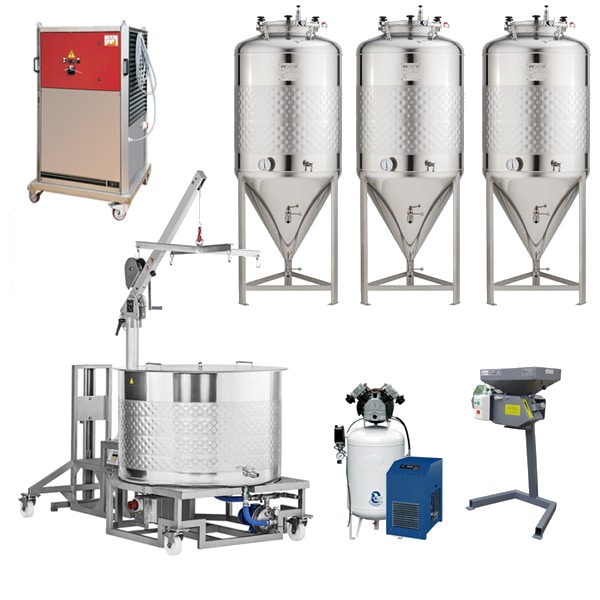
More about the BREWMASTER breweries …
Technical description – nanobreweries Brewmaster
I. Malt grinding
Malt grinding is carried by the electrical malt grinder MM-80 (output 80 kg of malt per hour) or the manual malt grinder MM-30 (output 30 kg of malt per hour)


II. Brewhouse – production of hot wort
- Brewmaster 50 (non-insulated infusion brewhouse) – production capacity: 50 liters of wort per batch
- Brewmaster 200 (insulated infusion brewhouse) – production capacity: 200 liters of wort per batch
- Brewmaster 500 (insulated infusion brewhouse) – production capacity: 500 liters of wort per batch
- Brewmaster 1000 (insulated infusion brewhouse) – production capacity: 1000 liters of wort per batch
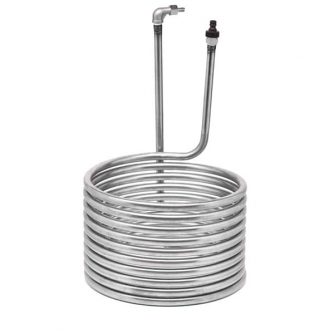 III. Wort Cooling to fermentation temperature
III. Wort Cooling to fermentation temperature
- Wort cooling directly in the brewhouse vessel or in the fermentation tank using submersible spiral heat exchanger – coolant is the cold tap water (first phase of wort cooling) and subsequently ice water from the water cooler (second phase of wort cooling)
- Wort cooling using block wort cooler – coolant is the cold tap water (first phase of wort cooling) and subsequently ice water from the water cooler (second phase of wort cooling)
- Pre-cooled wort cooling using water directly in the fermenter – only fermentation tanks equipped with water cooling
IV. Fermentation tanks – main fermentation
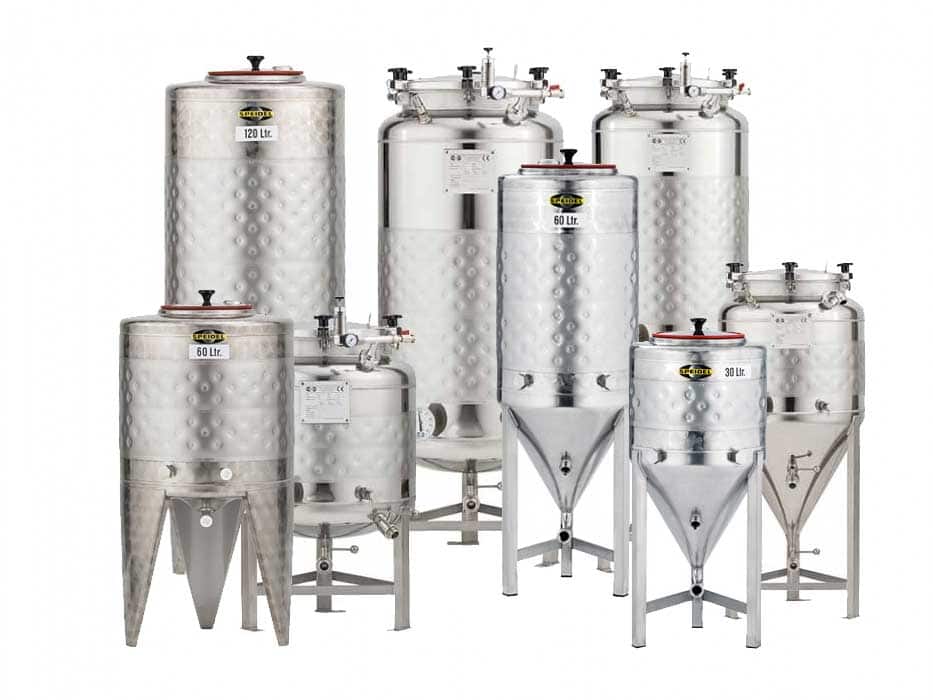
Simplified non-insulated cylindrical-conical fermentation tanks … cooled by regulating the room temperature – the simplest technology of uncontrolled beer fermentation in non-pressurized tank fitted with a fermentation plug and pure product drain valve. Recommended for beer production in small volumes without the possibility of precise temperature control. Low cost technology corresponds with the quality of workmanship and the inner surface of welds! Cleaning and sanitizing must be done manually.
- Simplified cylindrical-conical tanks – a cylindrical-conical tank in simplified design … cooled by duplicator and water cooler. Non-pressure (0.0 bar) or low pressure (1.5 bar) version. Tanks can also be used for wort cooling before the fermentation process. 1.5 bar version can also be used for low-pressure maturation and bottling of beer into containers.
- Fermentation & maturation self-cooled unit MODULO – a full-fledged cylindrical-conical tank in simplified design with integrated independent water cooler .. Non-pressure (0.0 bar), low pressure (1.5 bar) or high pressure (3.0 bar) version. Tanks can also be used for wort cooling before the fermentation process. 1.5 bar and 3.0 bar versions can also be used for low-pressure maturation and bottling of beer into containers.
- Classical cylindrical-conical tanks – fully equipped CCT, self-standing, insulated, equipped with everything needed for controlled fermentation, maturation, storage and bottling of beer. Cooling of all CCTs is provided by common water-glycol cooler. Programming temperature curves for many days in advance is possible.
V. Maturation tanks – maturation of beer
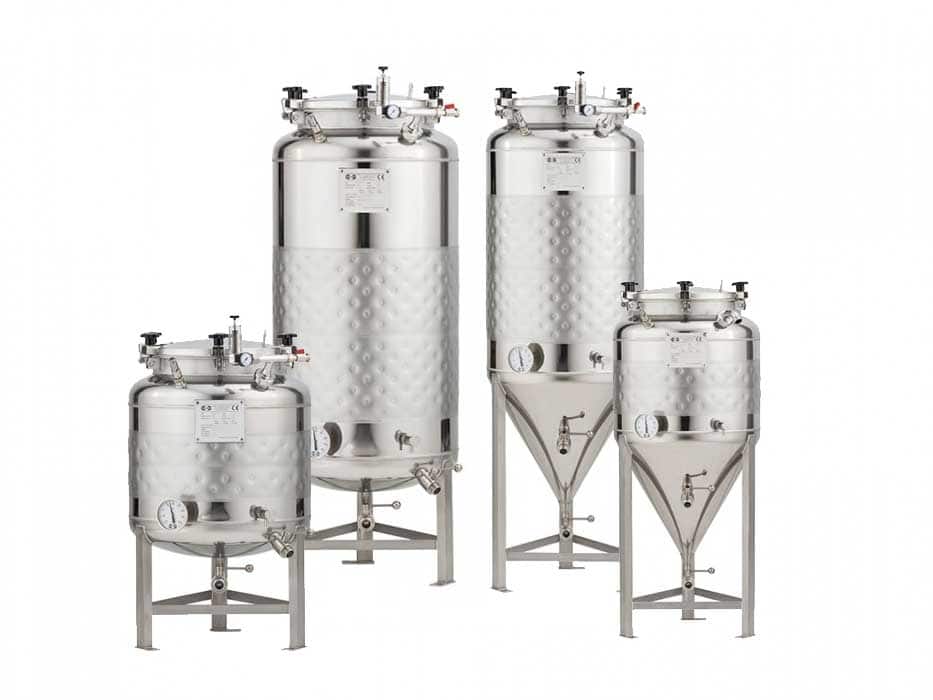
- Maturation directly in the sales packaging – we recommend pressure PET bottles, Petainer, Kegs, 5-liter beer kegs … While using this least expensive solution, it is always necessary to place the beer package in air-cooled rooms, refrigerator or cooled box (recommended air temperature around 1° C). It is also necessary to ensure continuous overpressure relief in containers to avoid containers’ explosion, because pressure containers are not intended by the manufacturer for purposes other than storage and sale of finished beer. That is why this maturation method is suitable only for the smallest production volumes. Because of the substantial risk of injury due to the risk of an explosion it is definitely not recommended.
- Maturation in overpressure tanks cooled by air – cooled air pressure tanks (certified for pressure from 1.5 to 3.0 bar) are non-insulated without duplicators for circulating of coolant. They are designed to be placed in a cold room or refrigerated box with air temperatures around 1° C. Equipment of pressure vessels (lager tanks) allows keeping exactly the set pressure in tanks and continuous draining of surplus amount of produced CO2 – this avoids the danger of tank explosion. With regard to the fact that all tanks are usually placed in a single room with a constant temperature, it is neither possible to control the temperature in each lager tank separately, nor is it possible to use these tanks for wort fermentation stage.
Maturation in overpressure tanks cooled by water (glycol) – overpressure tanks (certified for pressure from 1.2 to 3.0 bar) are non-insulated (SLP version) or insulated (CLASSIC version) equipped with cooling channels (duplicators). They are intended to be placed in unrefrigerated room (non-insulated tanks are recommended for isolated room). Each tank is individually cooled by coolant that circulates between duplication tank shell and water cooler.
Water (up to the temperature 2° C) or a mixture of water and food glycol (up to -4° C) is used as the coolant. Equipment of pressure vessels (lager tanks) allows keeping exactly the set pressure in tanks and continuous draining of surplus amount of produced CO2 this avoids the danger of tank explosion. Each tank is equipped with its own system of measurement and control of temperature and it is therefore possible to control the temperature in each tank separately. If the tanks are equipped with a conical bottom part (cylindrical-conical tanks), then it is possible to use the same tanks for the fermentation and also for maturation of beer. These versions of maturation tanks cooled by water (glycol) are suitable for nano-breweries:
- Simplified fermentation-maturation cylindrical-conical tanks – simplified CCTs (cooled by water, non-insulated)
- Fermentation & maturation unit MODULO – two CCTs (insulated or non-insulated) with integrated independent water cooler
- Fully equipped cylindrical-conical tanks – fully equipped insulated CCTs, self-standing, insulated, equipped with everything needed for controlled fermentation, maturation, storage and bottling of beer. Cooling of all CCTs is provided by common water-glycol cooler. Programming temperature curves for many days in advance is possible.
VI. The preparation of beer for sale
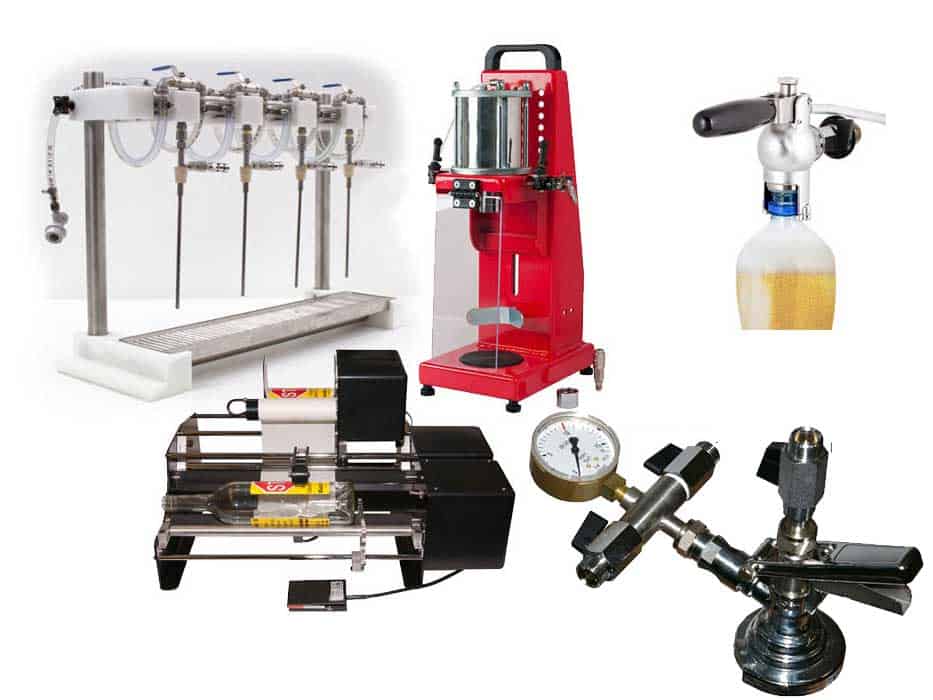
The anticipated production volumes in nano-breweries are so small that filling beer into sales packages is done mainly manually. Therefore, as part of the equipment for nano-breweries, we recommend following options:
- Hand-operated bottle fillers :
- Draft beer valve for filling of PET bottles
- Manual glass bottle filler (1 bottle)
- Manual glass bottle filler (2 bottles)
- Manual glass bottle filler (4 bottles)
- Manual bottle washer & blower
- Manual bottle crowner
- Hand-operated party keg filler :
- Hand-operated keg filler
VII. Cooling of brewing vessels
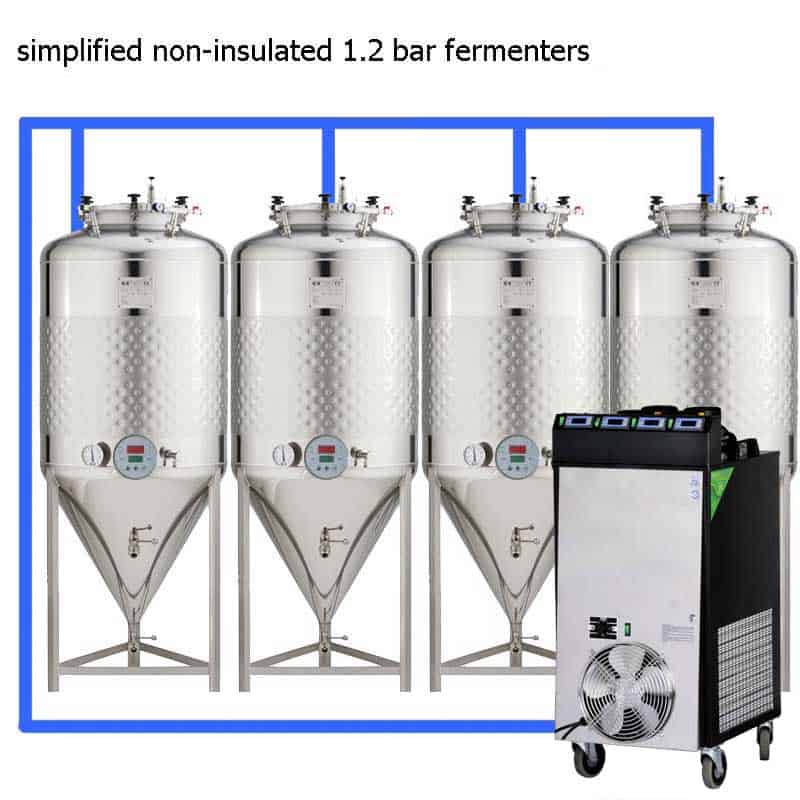
Cooling of tanks is done by one of the following ways (based on the choice of fermentation and maturation technologies):
- Air cooling – in choosing the simplest single-jacket tanks need to be placed in an isolated room equipped with an air cooling unit. The temperature in the room containing maturation tanks is recommended to be from 1 to 2° C (lower temperature could cause icing on the floor and on the technology). A possible solution is an industrial cooled box placed in a non-insulated room.
- Cooling by one water cooler – all tanks are cooled by one common cooler, from which the coolant (water or water with glycol) is distributed by means of pipes or hoses to individual tanks. Each tank has one or more cooling zones and the temperature in each zone is individually measured and controlled by the temperature control system. The advantage is the low power consumption. For nano-breweries’ purposes we use mainly compact water cooler which installation is manageable by the customers themselves. If necessary, it is possible to use the split water cooler with a separate exterior and interior parts (for such installation the service of specialized company is needed).
- Cooling by set of compact water coolers – each tank is cooled by a separate compact water cooler. Typical solution for fermentation and maturation units Modulo. The advantage is easy installation to the tanks without connection to the cooling pipes (manageable by the customers themselves) and substitutability of coolers – in case of failure of one cooler are all other tanks still in operation.
VIII. Recommended equipment
- Set of brewing tools – hydrometer, malt shovel, set of tools for easy cleaning of the brewhouse, tanks and hoses, malt barrel, wooden mash paddle
- Mobile pump – a useful tool for non-pressure pumping of beer and simple sanitation of tanks
- CIP station – a mobile unit for easy washing and sanitizing of tanks, pipes and hoses
